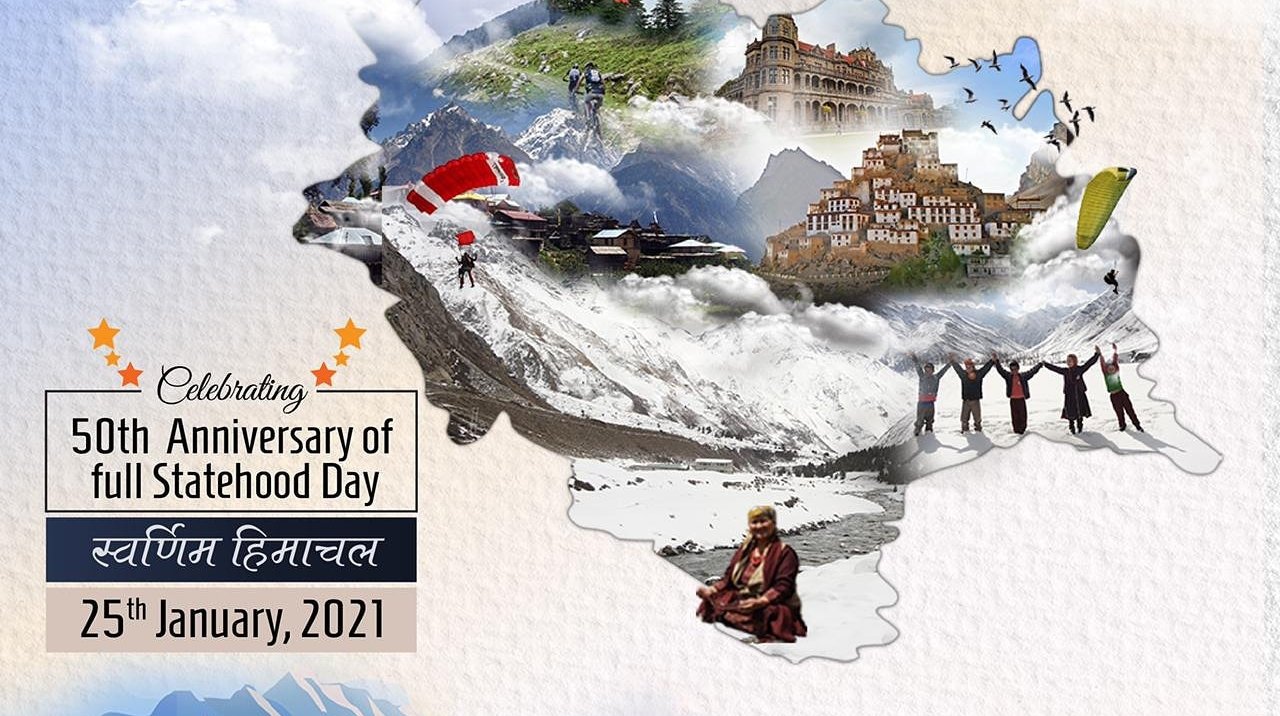
Image: HP Tourism
Writer: Anurag Garg (Assistant Commissioner, State Tax, Govt of HP)
Himachal Pradesh is set to complete 50 years as a full-fledged state on January 25 2021. Situated in the Western Himalayas, it is one of the eleven mountain states and is characterized by an extreme landscape featuring several peaks and extensive river systems. Present-day Himachal Pradesh has been inhabited since pre-historic times having witnessed multiple waves of human migration.
Original inhabitants of the hills of Himachal were Kols or Mundas, believed to have been pushed from the Indo-Gangetic plains towards the north by the Indus Valley Civilization. Mongoloid people called Bhotas and Kiratas formed the second wave of migration, followed by the third wave of people who came from Central Asia.
Mahabharata mentions several small republics or Janpadas, including the state of Kulindas in Shimla and Sirmaur hills, Kuluta in the Kullu valley, Trigarta in the foothills, and Audumbras in the lower hills between Pathankot and Jwalamukhi.
Later, under the Gupta Empire Ashoka introduced Buddhism in the hills. After the Gupta Empire, local chiefs called Thakurs and Ranas ruled the area but acknowledged the supremacy of Harsha in the early seventh century AD.
After Harsha’s death, a number of Rajput states emerged in Rajasthan and the Indus plains fighting among them. Some of the defeated Rajput leaders moved to the Himachal hills with their followers and set up at least 13 small states including Kangra, Mandi, Bilaspur, Bushahr and Sirmaur.
In the late 18th century, the Kangra dynasty regained power under Raja Sansar Chand, who expanded in neighbouring hill areas Chamba, Mandi and Bilaspur. The Gurkhas of Nepal annexed Sirmaur and Shimla hill states and then defeated Raja Sansar Chand at Kangra with the help of other smaller states in the area. After that, Sikhs under Ranjit Singh captured the Kangra Fort, expanding their rule to the neighbouring hill areas. But both the Gurkhas and Sikhs were ousted by the British in the Anglo-Gurkhas war and the First Anglo-Sikh War.
Under British rule, the states of Chamba, Mandi and Bilaspur made good progress in many areas. Rulers of the hill states were generally loyal to the Britishers, but the Indian freedom struggle found its way. Praja Mandal launched freedom struggle and the Congress party was particularly active in Kangra.
Following Independence, Himachal Pradesh first came into being as a centrally administered territory in April 1948 with the integration of 30 erstwhile princely states. In 1951, it became a ‘Part C’ state and was brought under a Lieutenant Governor with a 36-member Legislative Assembly. Bilaspur, another Part-C state was merged with Himachal in 1954. In 1956, despite majority recommendation of the States Reorganisation Commission for its merger with Punjab, Himachal Pradesh retained its separate identity, thanks to the famous dissenting note of the Commission’s Chairman Justice Fazal Ali which found favour with the Centre.
But Himachal was then made a Union territory in 1956. Kinnaur was made a new district in 1960 from Chinni Tehsil of Rampur. In 1962 legislative assembly was reinstated and in 1966, Kangra and most other hill areas of Punjab were merged with this UT. In December 1970, the state of Himachal Pradesh Act was passed by the Parliament. Finally, on January 25, 1971, Himachal Pradesh has declared a full-fledged state, becoming the 18th state of the Union of India.
After 1971, the state saw massive doses of the stimulus. The major sectors that were targeted include land reforms, horticulture, education, electricity, road network, health, animal husbandry, and employment. Land reforms were considered as the biggest achievement, as it ensured everyone has a piece of land.
Today Himachal Pradesh performs better in the human development index. Literary rate increases to 88 per cent, per capita income, is second highest in the country and with good health, infrastructure state achieved almost universal health system. The state is a role model for other states in good governance. We have time-bound public service delivery system for many services and also the e-governance model is becoming very robust in the state. State attracts around 196 Lakh tourists per year. There is a huge potential in the tourism sector and we can say in the service sector at large that the state should focus more on the service sector, for sustainable development of the state and also for employment generation.
Let us remember the sacrifices of the common populace and our leaders who brought us here where we are today celebrating the Golden Jubilee of our beautiful state and ensure that our actions would take the State to newer heights…
Read more: Solar pumps irrigation schemes proving beneficial to farmers of the state